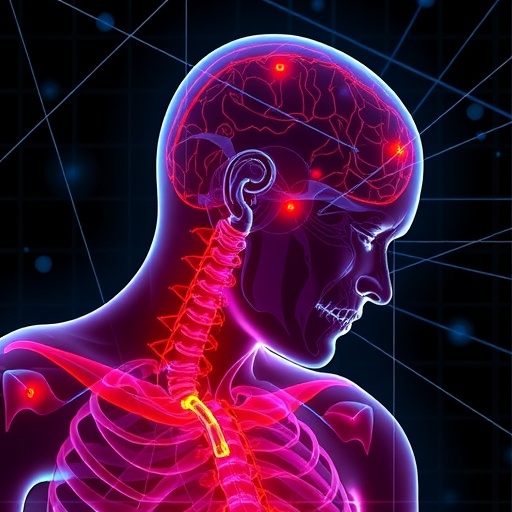
In a groundbreaking study elucidating the complex mechanisms underlying how mammals perceive temperature and pain, researchers have unveiled a distributed coding logic that governs thermosensation and inflammatory pain at the peripheral level. By integrating cutting-edge functional imaging techniques with precise transcriptomic classification, this work reveals how distinct populations of sensory neurons encode a spectrum of physical stimuli, particularly focusing on heat and noxious mechanical inputs, and how these encoding strategies undergo dynamic changes during inflammation.
One of the neuroscientific field’s longstanding challenges is deciphering the cellular and molecular logic that allows the somatosensory system to discriminate among diverse stimuli ranging from gentle touch to harmful heat. The current study systematically maps the sensory landscape at unprecedented resolution, distinguishing key neuronal populations and their specific receptive properties. The team’s data compellingly demonstrate that somatosensory neurons responding to gentle mechanical stimuli are segregated from those specialized for heat detection, underscoring a fundamental organizational principle in peripheral sensory coding.
Intriguingly, neurons expressing the well-known capsaicin receptor, TRPV1, showcased pronounced thermosensitivity and reliable responsiveness to warming stimuli. Yet, the study identifies a broader ensemble of C-fiber nociceptors that actively respond to noxious heat beyond TRPV1-expressing cells. Among these, Mrgprb4-expressing NP2B cells, previously implicated in affective touch behaviors such as gentle stroking and sexual response, unexpectedly manifest nociceptor-like tuning across the body rather than typical low-threshold mechanoreceptor (LTMR) characteristics. This finding challenges previous categorization and suggests a more versatile role for these neurons in thermal sensation.
By correlating the receptor and response profiles with genetic cell classes, the researchers further dissected the molecular underpinnings of sensory coding. Utilizing TRPV1 knockout mice, the study confirmed that TRPV1 mediates much of the innocuous warming detection attributed to PEP, NP2A, and NP3 neuronal subsets. Notably, TRPV1’s role in noxious heat detection was less pronounced than previously hypothesized based on in vitro experiments, highlighting the necessity of in vivo functional studies for accurate sensory mapping.
These findings collectively suggest that nociceptor classes do not exhibit exclusive tuning to single modalities; rather, an inverse relationship exists between mechanical and thermal sensitivity across C-nociceptor populations. All types respond to both heat and noxious mechanical stimuli but with graded, overlapping response spectra. This complex, combinatorial coding strategy allows the somatosensory system to achieve remarkable discriminatory power, enabling finely tuned perceptual experiences fundamental to survival.
Expanding beyond basic sensory encoding, the team investigated how peripheral inflammation modulates nociceptor activity and pain sensation. Prostaglandin E2 (PGE2)-induced inflammation elicited stimulus-independent spontaneous firing in multiple nociceptive neuron types and selectively sensitized these cells to heat, sparing gentle mechanical responses. This selective sensitization aligns closely with behavioral manifestations of heat allodynia and hyperalgesia observed during inflammatory states.
Critically, these inflammatory heat sensitizations were significantly dampened in TRPV1-deficient mice, corroborating TRPV1’s pivotal role in mediating thermal hypersensitivity under pathological conditions. However, spontaneous nociceptor activity, arguably central to ongoing inflammatory pain, persisted robustly in these knockouts. This distinction implies that TRPV1 antagonists might effectively alleviate heat hypersensitivity but may have limited efficacy against other dimensions of inflammatory pain such as spontaneous firing-driven tactile allodynia.
Moreover, the results highlighted the essential contribution of PIEZO2, a mechanically gated ion channel, in inflammatory tactile allodynia. Despite a relatively minor role in acute mechanonociception, PIEZO2’s involvement in chronic inflammatory pain emphasizes the multifaceted molecular mechanisms that govern sensory transformations under pathophysiological states. This insight deepens our understanding of why nociceptor ablation therapies can dramatically reduce pain without impairing normal touch or mechanical pain detection.
The authors also addressed methodological considerations, noting that their exclusive use of functional imaging focused on hairy skin-innervating neurons and relied on calcium transients as proxies for neuronal firing. While highly informative, this approach might miss subtle neuronal activity shifts that contribute incrementally to pain perception. The study thus serves as a foundational step, encouraging future investigations into glabrous skin and internal somatosensory targets such as bone, muscle, and viscera, where sensory coding may exhibit distinct patterns.
Furthermore, the temporal scope of inflammation examined was acute, leaving open the question of how chronic disease-associated pain states—such as diabetes, cancer, or sickle cell disease—alter sensory coding across cell classes over longer durations. Parsing these variations could reveal invaluable therapeutic targets for persistent pain management. Additionally, examining how convergent input from various heat-responsive nociceptors is integrated in central neural structures like the dorsal horn and spinal trigeminal nucleus remains a compelling avenue for future research.
Importantly, although all experiments were conducted in mice, the authors contextualize their findings in light of documented differences between mouse and human somatosensory neurons in molecular profiles and cell class distribution. Despite these interspecies variances, fundamental principles such as distributed heat coding among nociceptor classes and selective inflammatory modulation of neuronal activity are likely conserved, underscoring the translational potential of this research in informing human pain therapies.
This comprehensive study not only advances our fundamental understanding of somatosensory encoding but also highlights novel mechanistic insights into the cellular basis of inflammatory pain. It opens avenues for targeted pharmacological interventions aimed at discrete nociceptor populations and distinct pain modalities, potentially revolutionizing treatment paradigms for pain disorders that have long resisted effective management.
As the field moves forward, an integrated approach combining high-resolution transcriptomics, in vivo functional imaging, and behavioral analyses promises to refine our grasp of the somatosensory system’s intricate architecture. By disentangling the molecular and cellular circuits of pain and touch, we edge closer to decoding the neural language that shapes sensation, perception, and ultimately, human experience.
Subject of Research: Somatosensory coding of heat and inflammation-induced pain mechanisms
Article Title: A distributed coding logic for thermosensation and inflammatory pain
Article References:
Ghitani, N., von Buchholtz, L.J., MacDonald, D.I. et al. A distributed coding logic for thermosensation and inflammatory pain. Nature (2025). https://doi.org/10.1038/s41586-025-08875-6
Image Credits: AI Generated
Tags: C-fiber nociceptors in painchanges in sensory coding during inflammationencoding physical stimuli in neuronsfunctional imaging in neuroscienceinflammatory pain pathwaysmapping sensory landscapes in mammalsnociceptors and heat detectionsensory neuron populationssomatosensory system organizationthermosensation mechanismstranscriptomic classification of neuronsTRPV1 receptor and thermosensitivity





